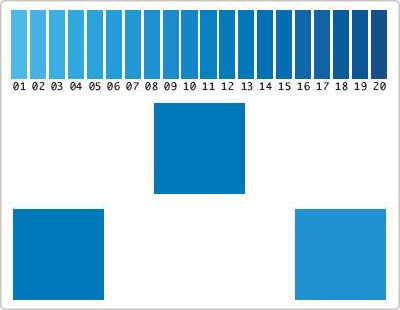Language influences color vision
Indigenous Russian speakers differentiate dark blue and pale blue differently from English speakers. A recent study of color perception has shown that the language you speak can affect how you see the world.
In Russian there is no separate word for " blue ", but always separate between the light blue, read " goluboy ", with dark blue, read " siniy ". Researcher Jonathan Winawer in the US has investigated whether this language distinction affects color perception.
The team recruited 50 people from Boston in Massachusetts, USA, of which nearly half are native Russian speakers. Participants are shown 3 blue squares on one screen and must show which square above matches the color with one of the two images below. There are 20 different blue colors in total.
Participants will take 2 tests. The first lesson, all 3 squares have the same color. The second lesson has a different colored square, for example, dark blue compared to lighter blue.

Participants must choose 1 of the 2 bottom squares to coincide with the square above.(Photo: Newscientist)
English speakers who distinguish dark blue and light blue are no better than when they realize that the two blue colors are the same. And the Russian speaker is 10% faster when distinguishing light blue (goluboy) with dark blue (siniy), compared to distinguishing 2 blue in the same category.
" This is the first time evidence shows that language differences relate to color perception in people ," Winawer said.
Moreover, when Russian speakers were forced to memorize an 8-digit number while taking a color test, they distinguished dark blue and light blue from nothing more than comparing the two colors. together. Winawer believes that it is because of the focus on remembering numbers that affects the language capacity in the brain and eliminating the advantage that Russian brings in distinguishing dark blue and light green.
MT
- Language changes the way you look at life
- The brain compensates for the loss of vision
- Programming language history
- Restoring ancient language
- Are there restrictions for the eyes?
- Colors help distinguish gender
- The 'new world' scenario if humans speak a common language
- Marvel at the world's least worded language with only 123 words
- Gloves turn speech language into words
- Oysters with language like?
- What language did the ancients use?
- Race against time to preserve language
 'Fine laughs' - Scary and painful torture in ancient times
'Fine laughs' - Scary and painful torture in ancient times The sequence of numbers 142857 of the Egyptian pyramids is known as the strangest number in the world - Why?
The sequence of numbers 142857 of the Egyptian pyramids is known as the strangest number in the world - Why? History of the iron
History of the iron What is alum?
What is alum? Is the blue whale's heart really the size of a car?
Is the blue whale's heart really the size of a car?  Top 3 birds that like to eat crocodiles: Number 1 also hunts snakes, a descendant of dinosaurs!
Top 3 birds that like to eat crocodiles: Number 1 also hunts snakes, a descendant of dinosaurs!  The secret under the gold leaves in the ancient scriptures over a thousand years old
The secret under the gold leaves in the ancient scriptures over a thousand years old  The end of the two-tone dress that divided social networks
The end of the two-tone dress that divided social networks  Chinese company opens space tourism ticket sales in 2027
Chinese company opens space tourism ticket sales in 2027  The bird with blue feet attracts the opposite sex with its unique dance.
The bird with blue feet attracts the opposite sex with its unique dance. 